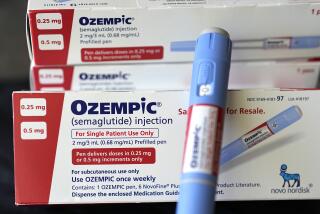Ready to Quit Smoking?
Itâs one instance where quitting isnât the easy way out.
FOR THE RECORD:
Zyban: In Mondayâs Health section, an article on quitting smoking said that the smoking-cessation medication Zyban might act by blocking the brain chemicals norepinephrine and dopamine. In fact, Zyban is believed to act by blocking the reuptake of norepinephrine and dopamine into nerve cells. This would enhance, not block, activity of the two chemicals. â
Most smokers try to stop multiple times before finally kicking the habit, and fewer than 10% will succeed in permanently abstaining without medicine or counseling.
Nearly 1 in 5 Americans are at least occasional smokers, risking cancer, heart disease and a shortened life span -- and costing the nation more than $193 billion annually, including healthcare costs and decreased workplace productivity among smokers, the CDC says. They continue to light up even as employers increasingly charge higher health insurance premiums for smokers.
Nicotineâs hold on the brain is not easily broken, as the struggles of President Obama -- a very self-disciplined man by all accounts -- illustrate. Many would-be quitters, like the president, relapse when the appeal of nicotine is simply too strong.
For the vast majority who canât go it alone, researchers and pharmaceutical companies are developing new treatments that can help smokers stub out that final butt. And they are finding newer, more effective ways to use nicotine-replacement therapies such as gum and patches.
In short, says Dr. Michael Fiore, director of the Center for Tobacco Research and Intervention at the University of Wisconsin, though there is no magic bullet, âItâs a great time to quit.â
Nicotine replacements
Nicotine replacement therapies, which have been around since the 1980s, work by fulfilling the desire for nicotine in a noncigarette form. Nicotine replacements come in patches, gum, lozenges, inhalers and nasal sprays.
The Food and Drug Administration has approved each medication for use on its own, and only for quitting cold turkey. Many smokers would prefer to quit gradually.
âThereâs a kind of mythology that if you smoke while using one of these nicotine-replacement products, thatâs toxic,â says Saul Shiffman, a psychologist at the University of Pittsburgh. During the 1990s, there were rumors that smoking while using a nicotine patch could lead to heart attacks. Studies have found no safety risk in using cigarettes and nicotine replacements simultaneously, Shiffman says.
In a recent analysis, published in 2008 in the journal Addiction, Shiffman concluded from four separate studies that starting the nicotine patch two weeks before quitting cigarettes doubles a smokerâs chance of success. Some subjects used the patch before quitting, while others did not, and Shiffmanâs analysis examined whether people were smoke-free six weeks, and then six months, after a target quit date. In three of the studies, patch users were smoking fewer cigarettes even before their planned quit day, though they had not been told to do so.
The therapy might work by breaking the association between lighting up and getting the pleasure of nicotine, says Jed Rose, director of the Duke Center for Nicotine and Smoking Cessation Research in Durham, N.C. âCigarettes become less enjoyable when smoking on the patch, just as eating when youâre not hungry is not as rewarding as when you are,â Rose says.
In another study, published this month in the American Journal of Preventive Medicine, Shiffman and colleagues showed that use of nicotine gum before quitting also helps people stop smoking. The researchers instructed more than 3,000 smokers to taper off cigarette use while chewing gum that contained zero, 2 or 4 milligrams of nicotine. Those on nicotine-containing gum were three times more likely to quit and still be abstinent at six months (6% of people on nicotine gum, compared with 2% on placebo gum); those on 4 milligrams had the best results overall, with odds of quitting six times greater than people on a placebo.
In 2008, the U.S. Department of Health and Human Services released revised guidelines for tobacco-addiction treatment that discuss gradually trading cigarettes for nicotine replacements. However, the authors chose not to recommend pre-quitting nicotine replacement use yet, citing the limited number of studies.
The guidelines do recommend mixing replacement aids, based on five studies that found using the patch plus gum (versus patch alone) nearly doubles the likelihood of quitting. Smokers might use the patch to control baseline cravings but pop a piece of gum or lozenge when the urge for a drag intensifies.
âI think no one should use one nicotine replacement anymore,â says Dr. John Hughes, a psychiatrist at the University of Vermont in Burlington.
Zyban
Zyban, the commercial name for bupropion, is a smoking cessation aid that contains no nicotine. It was first marketed as the antidepressant Wellbutrin by Brentford, England-based GlaxoSmithKline. Unexpectedly, smokers using the pill reported that their cigarette cravings decreased. After three studies confirmed the effect, the company in 1997 repackaged bupropion as Zyban.
Bupropion battles the irritability, depression and restlessness that come with nicotine withdrawal. Scientists think it might act by blocking the brain chemicals norepinephrine and dopamine.
An independent 2006 review by the nonprofit Cochrane Collaboration pooled 40 studies on bupropion and found that it doubled a personâs chance of quitting. Studies havenât found this effect with selective serotonin reuptake inhibitors, the antidepressants class that includes Prozac and Zoloft. A handful of studies suggest that the antidepressant nortriptyline also helps people quit, but the FDA has not evaluated this medication for smoking cessation use.
The most common side effects of bupropion include anxiety, dry mouth and insomnia. Seizures are also a risk and occur in about 1 in 1,000 people using Zyban. In Wellbutrin users, who frequently take higher doses of bupropion, psychological effects such as hallucinations also have been reported. The FDA has approved using bupropion at the same time as the nicotine patch.
Chantix
Varenicline, marketed in the U.S. since 2006 as Chantix by New York-based Pfizer Inc., was the first new smoking-cessation drug in nearly a decade.
The drug works by attaching to the brainâs nicotine receptors, preventing nicotine from stimulating them. (Since it interferes with the brainâs ability to sense nicotine, it is not recommended in combination with nicotine-replacement therapies.) Varenicline also dampens the symptoms of nicotine withdrawal by partially activating the nicotine receptors. âItâs like taking out a 100-watt light bulb and putting in a 60-watt light bulb,â Hughes says. The most common side effect is nausea. Some patients also report vivid dreams.
A 2007 Cochrane report examined nine studies on varenicline, encompassing more than 7,000 subjects. Overall, varenicline doubled or tripled quit rates compared with inactive placebos. It also worked somewhat better than the nicotine patch or bupropion, making it a top choice among many physicians and patients.
But Chantix has also raised concerns. During the fourth quarter of 2007, the FDA received nearly 1,000 reports of serious injury (such as accidents, falls, heart arrhythmias or seizures) or psychological disturbances (such as hostile or suicidal thoughts) for people taking varenicline.
No study has analyzed these side effects in detail, so it is not clear how many of them were caused by the drug. âThereâs reason to worry, but thereâs not enough data to understand how much to worry, or who to worry about,â Shiffman says.
The FDA advises patients to tell their doctors about any history of psychiatric illness, and says doctors and family members should monitor Chantix users for changes in mood or behavior. The Federal Aviation Administration has banned pilots and air traffic controllers from taking the drug. But most doctors feel that Chantix is safe and are comfortable prescribing it to the majority of patients.
Nicotine vaccines
In the next several years, doctors may have a new anti-smoking aid in their tool kit: a nicotine vaccine. The vaccine encourages the body to produce antibodies that bind to nicotine, preventing it from reaching the brain. When nicotine is blocked, smoking isnât satisfying anymore.
In preliminary results announced in 2007, Nabi Biopharmaceuticals of Rockville, Md., found that its NicVAX more than doubled quit rates. In the study of 301 patients, of those receiving NicVAX, 14% to 16% managed to stay off cigarettes for one year, compared with 6% of people who received a placebo. Last fall, Nabi reached a special agreement with the FDA to fast-track approval of the vaccine if a larger drug trial shows positive results.
Nabi uses a slow-vaccination strategy, with patients getting a shot every month for four months before they quit. Subjects did not experience cravings or withdrawal, and some quit smoking before the target date of four months, says Nabi President Raafat Fahim.
Novartis AG in Switzerland is also developing a nicotine vaccine that is being tested in a clinical trial. Novartis expects that the treatment will be available in 2012 at the earliest, spokesman Peter Shelby says.
Financial incentives
All smoking cessation aids ultimately hinge on one necessity: the desire to quit. Motivation can come from concerns about the health of oneself or others, or from the social awkwardness of having what is increasingly viewed as a nasty habit. Some employers refuse to hire a job candidate who smokes. If those arenât reason enough, a Feb. 12 study in the New England Journal of Medicine suggests that cash is the incentive some people need.
Dr. Kevin Volpp of the University of Pennsylvania in Philadelphia and colleagues partnered with General Electric, headquartered in Fairfield, Conn., to recruit 878 smoking employees for the study. Half received information about local programs that could help them quit. The others received information plus the promise of a reward if they could become and remain smoke-free.
Completing a treatment program was worth $100, quitting by six months earned $250, and the biggest payoff -- $400 -- went to people who managed to quit and stay off cigarettes for at least six months. In the incentive group, 9% of people were still nonsmokers after more than one year, compared with 4% of people who lacked the financial motivation.
Paying people to abstain beyond six months was important, Volpp says, because quitters often relapse early on.
GE is excited about the results, says its chief medical officer, Dr. Robert Galvin. The company estimates that its U.S. employees who smoke cost it $50 million in additional healthcare costs annually. GE plans to implement an incentive program in 2010.
Kenneth Warner, an economist at the University of Michigan in Ann Arbor, says Volppâs research provides a strong argument that financial incentives work. But, he noted, nonsmokers might feel cheated when their smoking colleagues are offered rewards. âThere are some fairness issues,â he says.
For more information on quitting, visit smokefree.gov. All states have free telephone quit lines: the number in California is (800) NO-BUTTS (662-8887). Nationwide, dial (800) QUIT-NOW (784-8669).






